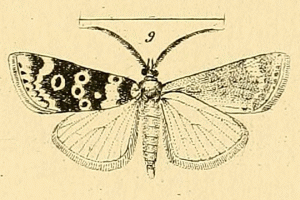
Lineodes is a genus of snout moths of the subfamily Spilomelinae in the family Crambidae. The genus was described by Achille Guenée in 1854, with Lineodes hieroglyphalis as the type species.

Pilocrocis is a genus of moths of the family Crambidae. The genus was first erected by Julius Lederer in 1863.
Aglossa exsucealis is a species of snout moth in the genus Aglossa. It was described by Julius Lederer in 1863 from Beirut, Lebanon. It is also found on Cyprus.

Aglossa ocellalis is a species of snout moth in the genus Aglossa. It was described by Julius Lederer in 1863 and is known from Uganda and the Democratic Republic of the Congo. There is one record of an accidental introduction from Scotland.
Omphalocera cariosa is a species of snout moth, and the type species in the genus Omphalocera. It was described by Julius Lederer in 1863. It is found from North America to Brazil.

Glaphyriinae is a subfamily of the lepidopteran family Crambidae. It was described by William Trowbridge Merrifield Forbes in 1923. The subfamily currently comprises 509 species in 75 genera.
Crocidophora pustuliferalis is a moth in the family Crambidae. It was described by Julius Lederer in 1863. It is found in North America, where it has been recorded from Alabama, Arkansas, Florida, Indiana, Maryland, New Mexico, North Carolina, Oklahoma and South Carolina.

Crocidophora tuberculalis, the pale-winged crocidiphora moth, is a moth in the family Crambidae. It was described by Julius Lederer in 1863. It is found in North America, where it has been recorded from Alabama, Florida, Georgia, Illinois, Indiana, Maine, Maryland, Massachusetts, Mississippi, New Hampshire, North Carolina, Ohio, Oklahoma, Ontario, Quebec, South Carolina, Tennessee, Texas, Virginia, West Virginia and Wisconsin.
Euclasta maceratalis is a moth in the family Crambidae. It was described by Julius Lederer in 1863. It is found in northern Australia, where it has been recorded from Queensland.
Ostrinia obumbratalis, the smartweed borer, is a moth in the family Crambidae. It was described by Julius Lederer in 1863. It is found in North America, where it has been recorded from New Brunswick and Manitoba to Louisiana and Florida.

Saucrobotys futilalis, the dogbane saucrobotys moth, is a moth in the family Crambidae. It was described by Julius Lederer in 1863. It is found in North America, where it has been recorded from the north-east to British Columbia and south to Texas and California.
Coenostolopsis apicalis is a species of moth in the family Crambidae. It was described by Julius Lederer in 1863. It is found in Brazil.

Syllepte glebalis is a moth in the family Crambidae. It was described by Julius Lederer in 1863. It is found in Cameroon, the Democratic Republic of the Congo, Ivory Coast, Madagascar, Nigeria, Sierra Leone, Zambia and Zimbabwe.

Nosophora semitritalis is a species of moth in the family Crambidae. It was described by Julius Lederer in 1863. It is found in China, Thailand, Taiwan and Japan.
Omiodes martyralis is a moth in the family Crambidae. It was described by Julius Lederer in 1863. It is found in Argentina, Venezuela, Brazil, Puerto Rico, Costa Rica and Mexico.
Pycnarmon praeruptalis is a moth in the family Crambidae. It was described by Julius Lederer in 1863. It is found on Indonesia's Ambon Island and Papua New Guinea.

Agroterini is a tribe of the species-rich subfamily Spilomelinae in the pyraloid moth family Crambidae. The tribe was erected by Alexandre Noël Charles Acloque in 1897.

Margaroniini is a tribe of the species-rich subfamily Spilomelinae in the pyraloid moth family Crambidae. The tribe was erected by Charles Swinhoe and Everard Charles Cotes in 1889, originally as family Margaronidae.

Steniini is a tribe of the species-rich subfamily Spilomelinae in the pyraloid moth family Crambidae. The tribe was erected by Achille Guenée in 1854.
Cheverella is a monotypic genus of snout moths in the subfamily Spilomelinae of the family Crambidae. It contains only one species, Cheverella galapagensis, which is endemic to the Galápagos Islands of Ecuador. Both the genus and the species were first described by Bernard Landry in 2011. The genus is placed in the tribe Udeini.











